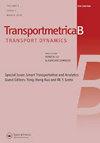Discharge control policy based on density and speed for deep Q-learning adaptive traffic signal
IF 3.4
2区 工程技术
Q2 TRANSPORTATION
引用次数: 1
Abstract
This study introduces a control strategy based on intersection capacity. The optimisation technique is formulated from available space at discharge routes. The downstream policy utilises density and speed (k-v) measurements to guide a deep Q-learning agent (DQLA) in managing a signalised junction using a constrained local communication protocol. Testing of the DQLA k-v strategy against other control methods is carried out in a simulated micro-model of a real urban traffic network. Though the adaptive signal system design is decentralised, statistical analyses explicitly prove the effectiveness of the discharge-based controller in mitigating operation at a global scale. The DQLA k-v controller has achieved significant cost savings in waiting time (10%−36%) and travel time (5%−25%) and asserted the highest mean travel speed (3.4 m/s). Consequently, vehicular traffic experienced the least time loss when traversing routes and witnessed fewer stops leading to close to optimum network operation at a 0.80 clearance ratio.基于密度和速度的深度q学习自适应交通信号流量控制策略
本文章由计算机程序翻译,如有差异,请以英文原文为准。
求助全文
约1分钟内获得全文
求助全文
来源期刊

Transportmetrica B-Transport Dynamics
TRANSPORTATION SCIENCE & TECHNOLOGY-
CiteScore
5.00
自引率
21.40%
发文量
53
期刊介绍:
Transportmetrica B is an international journal that aims to bring together contributions of advanced research in understanding and practical experience in handling the dynamic aspects of transport systems and behavior, and hence the sub-title is set as “Transport Dynamics”.
Transport dynamics can be considered from various scales and scopes ranging from dynamics in traffic flow, travel behavior (e.g. learning process), logistics, transport policy, to traffic control. Thus, the journal welcomes research papers that address transport dynamics from a broad perspective, ranging from theoretical studies to empirical analysis of transport systems or behavior based on actual data.
The scope of Transportmetrica B includes, but is not limited to, the following: dynamic traffic assignment, dynamic transit assignment, dynamic activity-based modeling, applications of system dynamics in transport planning, logistics planning and optimization, traffic flow analysis, dynamic programming in transport modeling and optimization, traffic control, land-use and transport dynamics, day-to-day learning process (model and behavioral studies), time-series analysis of transport data and demand, traffic emission modeling, time-dependent transport policy analysis, transportation network reliability and vulnerability, simulation of traffic system and travel behavior, longitudinal analysis of traveler behavior, etc.
 求助内容:
求助内容: 应助结果提醒方式:
应助结果提醒方式:


